6~7세 학령기 아이들의 성장 발육, Growth and development of 6~7-year-old school children
| 6~7세 학령기 아이들의 성장 |
표 3-40. 6세 한국 학령기 아이들의 체중과 신장의 백분위수
|
백분위 수
성별 |
3 | 10 | 25 | 50 | 75 | 90 | 97 | |
| 남아 | 체중(kg) | 14.10 | 16.00 | 17.00 | 18.40 | 20.00 | 21.50 | 22.80 |
| 남아신장(cm) | 90.7 | 101.9 | 106.5 | 110.8 | 114.8 | 118.0 | 121.0 | |
| 여아 | 체중(kg) | 14.00 | 15.10 | 16.50 | 17.85 | 19.20 | 20.50 | 22.00 |
| 여아신장(cm) | 97.3 | 101.5 | 105.0 | 109.5 | 113.5 | 116.0 | 118.5 |
표 3-41. 6세 6개월 한국 학령기 아이들의 체중과 신장의 백분위수
|
백분위 수
성별 |
3 | 10 | 25 | 50 | 75 | 90 | 97 | |
| 남아 | 체중(kg) | 15.10 | 16.30 | 17.50 | 18.80 | 20.05 | 22.50 | 23.00 |
| 남아신장(cm) | 102.1 | 106.2 | 109.4 | 113.0 | 116.5 | 119.4 | 123.0 | |
| 여아 | 체중(kg) | 14.60 | 16.00 | 17.00 | 18.20 | 19.70 | 21.00 | 22.10 |
| 여아신장(cm) | 100.0 | 105.5 | 109.9 | 112.7 | 115.8 | 118.5 | 121.0 |
- 아이의 체중과 신장을 잰다.
- 아이의 체중 치와 신장 치를 성장차트 체중·신장 백분위선에 그려 넣고 체중과 신장이 성장차트 백분위선 상 어디에 있는지 알아본다.
- 그 아이의 체중과 신장이 전과 거의 같은 성장차트 체중·신장 백분위선을 따라 계속 증가하면서 정상적으로 키와 몸무게가 잘 증가하나 알아본다.
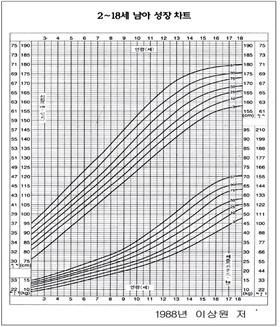
그림 3-196. 2~18세 한국 남아들의 체중과 신장의 성장차트와 백분위수.
Copyright ⓒ 2012 John Sangwon Lee, MD ., FAAP
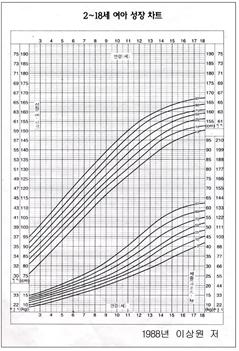
그림 3-197. 2~18세 한국 여아들의 체중과 신장의 성장차트와 백분위수.
Copyright ⓒ 2012 John Sangwon Lee, MD., FAAP
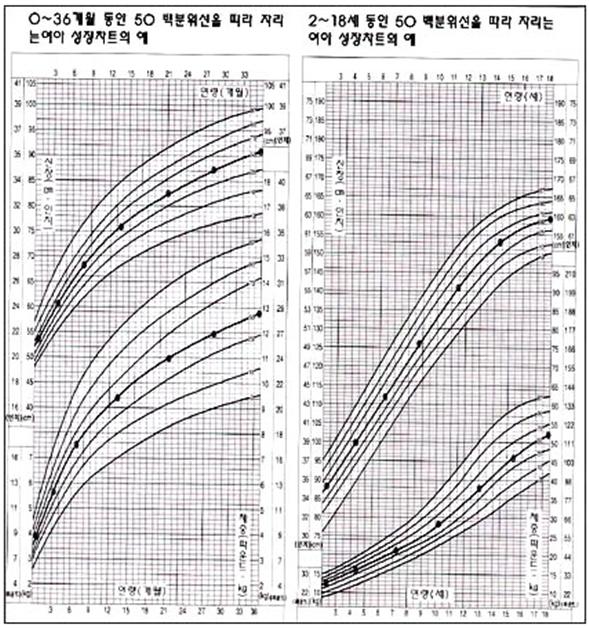
그림 3-198. 0~18세 아이들의 체중과 신장차트. 체중과 신장이 성장 차트 5퍼센타일 백분위선을 따라 성장하는 여아의 성장차트의 예.
Copyright ⓒ 2012 John Sangwon Lee, MD., FAAP
| 소아청소년 예측체중신장주기와 소아청소년 예측 체중 신장 계산공식 참조 |
| 6~7세 학령기 아이들의 발육 |
1. 6~7세 학령기 아이들의 신체 발육
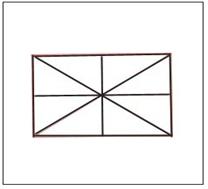
그림 3-199. 6세 아이들의 대부분은 위에 있는 그림을 보고 그릴 수 있다.
Copyright ⓒ 2012 John Sangwon Lee, MD., FAAP
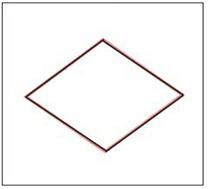
그림 3-200. 7세 아이들의 대부분은 마름모꼴을 보고 그릴 수 있다.
Copyright ⓒ 2012 John Sangwon Lee, MD., FAAP
- 전보다 공을 더 잘 던질 수 있다.
- 두 눈을 감고 한쪽 발로 번갈아 설 수 있다.
- 전보다 더 현저하게 여아들은 여아들답게 남아들은 남아들답게 몸가짐을 갖는다.
2. 6~7세 학령기 아이들의 손 발육
- 마름모꼴을 보고 그릴 수 있고
- 옷을 입고 있는 사람을 보고 그리라고 하면 옷을 입고 있는 사람의 목과 두 손 그리고 입고 있는 옷을 그릴 수 있다.
- 5 이하 숫자로 더하기와 빼기를 할 수 있다.
3. 6~7세 학령기 아이들의 언어 발육
- 문법에 맞게 단문을 말로 할 수 있다.
- 적어도 다섯 개 낱말로 구성된 문장의 뜻을 이해할 수 있고,
- 적어도 30까지 셀 수 있다.
4. 6~7세 학령기 아이들의 사회성 발육
- 오전과 오후를 구별할 수 있다.
- 신발 끈을 매고 신발을 신을 수 있다.
- 오른쪽과 왼쪽을 분별할 수 있다.
- “생후 1개월~6세의 영유아들의 발육 이정표” 참조
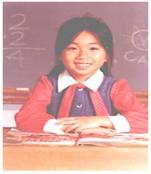
사진 3-201. 6~7세 여아들은 여아들답게 옷을 입고 남아들은 남아들답게 옷을 입고 남녀 이성의 구별이 확실해 진다.
Copyright ⓒ 2012 John Sangwon Lee, MD, FAAP
| 장난감 |
장난감 참조
| 6~7세 학령기 아이들의 영양과 양호 |
- 이 나이 초기 학령기 아이들의 대부분의 성장 속도가 정상적으로 느리고 일부는 음식물을 잘 먹지 않는 것같이 보인다.
- 그렇지만 정기 건강검진을 하고 성장 발육의 정도를 평가해보면 실제로 그들은 매일 필요로 하는 균형 잡힌 영양가 있는 음식물을 적절히 잘 먹고 있다는 것을 알 수 있다.
- 하루에 주식을 3 번, 주식과 주식 사이에 간식을 1~2 번 정도 먹을 수 있다.
- 어떤 아이들을 자기 맘대로 혼자서 패스트푸드를 사먹을 수 있다. 패스트푸드만 주로 먹지 않게 주의한다.
- 균형 잡힌 영양가 있는 음식물을 충분히 먹는 학령기 아이들에게 비타민제나 철분제를 가외로 매일 줄 필요가 없다.
- 일부 학령기 아이들은 식욕이 왕성해서 전보다 더 잘 먹기 시작한다.
- 특히 사춘기가 시작되기 바로 전 학령기 여아들은 식욕이 아주 왕성해질 수 있다.
- 엄마 아빠는 이 시기의 학령기 아이들에게 눈길 접촉으로, 신체적 접촉으로, 집중적 관심적 사랑과 보살핌으로 조건 없는 진정한 사랑을 많이많이 해 주어야 한다.
- 특히 한 집안에 여러 학령기 자녀들이 있을 때 엄마아빠는 그들 중 한 자녀만 데리고 어디를 가서 그 자녀에게 집중적, 관심적 사랑을 많이 해 주면서 많이 보살펴 주어야 한다.
- 이렇게 집중적, 관심적 사랑을 해줄 때 시간이 많이 걸리고 때로는 실행하기가 어렵지만 그런 사랑을 모든 학령기 자녀에게 골고루 아낌없이 해준 후 돌려받을 수 있는 대가는 한량없이 크다.
- 다른 아이들에게도 같은 방법으로 집중적 관심적 사랑을 많이 해주어야 한다.
- 이런 식으로 모든 자녀들에게 집중적 관심적 사랑을 골고루 해주어야 한다.
- 그 학령기 아이가 남아이건 여아이건 둘째 자녀이건 첫째 자녀이건, 장래성이 많이 있건 없건, 똑똑하건 바보 같건, 병신 같건, 예쁘건 잘 생겼건, 못 생겼건, 공부를 잘하건 못하건, 키가 크든 작든, 뚱뚱하건 홀쭉하건, 어떻게 행동하건 그 자식을 무조건적으로 사랑해야 한다. 이런 사랑을 조건 없는 사랑이라고 한다.
- 그렇게 사랑을 하기가 어렵다.
- 그렇지만 최선을 다해서 조건 없는 사랑을 해야 한다.
- 부모로부터 조건 없는 사랑을 충분히 받고 자란 아이들은 무엇을 하든지 최선을 다할 수 있다.
- 조건 없는 사랑을 한다고 해도 자녀의 그릇된 행동이나 말도 사랑 하라는 것은 아니다.
- 자녀 사랑 참조.
- [부모도 반의사가 되어야 한다-소아가정간호 백과]-제 22권 아들 딸 이렇게 사랑해 키우세요-사랑 참조
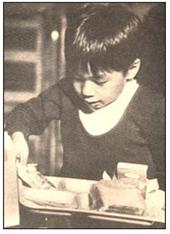
사진 3-202. 많이 먹고 이것저것 가리지 않고 잘 먹는 학령기 아이들도 있다.
Copyright ⓒ 2012 John Sangwon Lee, MD., FAAP
Growth and development of 6-7-year-old school children
Growth of 6-7-year-old school-age children
Table 3-40. Percentiles of weight and height for 6-year-old Korean school-age children percentile
표 3-40. 6세 한국 학령기 아이들의 체중과 신장의 백분위수
|
percentile
Gender |
3 | 10 | 25 | 50 | 75 | 90 | 97 | |
| boy | weight(kg) | 14.10 | 16.00 | 17.00 | 18.40 | 20.00 | 21.50 | 22.80 |
| height(cm) | 90.7 | 101.9 | 106.5 | 110.8 | 114.8 | 118.0 | 121.0 | |
| girl | weight(kg) | 14.00 | 15.10 | 16.50 | 17.85 | 19.20 | 20.50 | 22.00 |
| height(cm) | 97.3 | 101.5 | 105.0 | 109.5 | 113.5 | 116.0 | 118.5 |
Table 3-41. Percentiles of weight and height for Korean school-age children 6 years and 6 months percentile 표 3-41. 6세 6개월 한국 학령기 아이들의 체중과 신장의 백분위수
|
percentile
Gender |
3 | 10 | 25 | 50 | 75 | 90 | 97 | |
| boy | weight(kg) | 15.10 | 16.30 | 17.50 | 18.80 | 20.05 | 22.50 | 23.00 |
| height(cm) | 102.1 | 106.2 | 109.4 | 113.0 | 116.5 | 119.4 | 123.0 | |
| girl | weight(kg) | 14.60 | 16.00 | 17.00 | 18.20 | 19.70 | 21.00 | 22.10 |
| height(cm) | 100.0 | 105.5 | 109.9 | 112.7 | 115.8 | 118.5 | 121.0 |
• Measure the child’s weight and height.
• Draw the child’s weight and height values on the growth chart weight and height percentiles and find out where the weight and height are on the growth chart percentiles.
• Check whether the child’s weight and height increase normally while continuing to increase along with the weight and height percentiles of the growth chart, almost the same as before.

Figure 3-196. Growth charts and percentiles of weight and height for Korean boys aged 2 to 18 years old. Copyright ⓒ 2012 John Sangwon Lee, MD ., FAAP

Figure 3-197. Growth charts and percentiles of weight and height for Korean girls aged 2 to 18 years. Copyright ⓒ 2012 John Sangwon Lee, MD., FAAP

Figure 3-198. Weight and height charts for children aged 0-18 years. Example of a growth chart for a girl with weight and height growing along with the 5th percentile of the growth chart. Copyright ⓒ 2012 John Sangwon Lee, MD., FAAP
Refer to the children and adolescents predicted weight-growth and the formula for the predicted weight and height for children and adolescents
Development of 6-7-year-old school-age children
1. Physical development of 6-7-year-old school-age children

Figure 3-199. Most 6-year-olds can see and draw the picture above. Copyright ⓒ 2012 John Sangwon Lee, MD., FAAP

Figure 3-200. Most 7-year-olds can see and draw rhombuses. Copyright ⓒ 2012 John Sangwon Lee, MD., FAAP
• They can throw the ball better than before.
• Close his eyes and take turns standing on one foot.
• More significantly than before, girls behave like girls and boys behave like boys.
2. Hand development of 6-7-year-old school-age children
• Can see and draw a rhombus
• If you ask him to look at the person wearing the clothes and you ask him to draw the person, he can draw the person’s neck and hands and the clothes they are wearing.
• You can add and subtract with numbers 5 or less.
3. Language development of 6-7-year-old school-age children
• Can speak short sentences according to grammar.
• Can understand the meaning of sentences of at least five words;
• He can count to at least 30.
4. Social development of 6-7-year-old school-children
• Able to distinguish between morning and afternoon.
• Able to put on shoes by tying shoelaces.
• Can distinguish right and left.
• See “Developmental Milestones for Infants 1 Month to 6 Years Old”

Picture 3-201. 6-7-year-old girls dress like girls, boys dress like boys, and the gender distinction between men and women becomes clear. Copyright ⓒ 2012 John Sangwon Lee, MD, FAAP
Toy – toy reference
Nutrition and good health of school-age children aged 6-7 years
• Most early school-age children of this age grow normally slowly, and some appear to be poorly fed.
• However, regular health check-ups and evaluation of their growth and development can actually show that they are eating adequately the well-balanced, nutritious food they need every day.
• They can eat 3 main meals a day and 1-2 snacks between meals.
• Some children can eat fast food on their own at will. Be careful not to eat only fast food.
• School-age children who eat a well-balanced, nutritious diet do not need extra daily vitamins or iron supplements.
• Some school-age children have a strong appetite and begin to eat better than before.
• School-age girls, especially just before the onset of puberty, can have very strong appetites.
• Mom and Dad should give a lot of unconditional true love to school-age children at this age through eye contact, physical contact, and intensive focused attention love and care.
• Especially when there are several school-age children in the household, moms and dads should take only one of them wherever they go and take great care of them, giving them a lot of her focused attention love, caring love.
• Giving such attention love and caring love takes a lot of time and is sometimes difficult to implement, but the price that can be returned after giving such love to all school-age children evenly is immeasurable.
• Other children should be given a lot of focused attention love and care in the same way.
• In this way, you should give all your children even intensive attention love care and love.
• Whether the school-age child is a boy or a girl, a second child or a first child, with a lot of prospects or not, smart or stupid, asshole, pretty or handsome, ugly, well-educated or not, tall, you must love your child unconditionally, no matter how small, fat or slender he behaves. This kind of love is called unconditional love.
• It’s hard to love like that.
• However, you must do your best to love unconditionally.
• Children who grow up with enough unconditional love from their parents can do their best in whatever they do.
• Even if you love unconditionally, it does not mean that you should love your child’s wrong actions or words.
• See Love for Children.
• www.drleepediatrics.com-Volume 22, Raise Your Sons and Daughters to Love Like This-See Love

Picture 3-202. There are school-age children who eat a lot and eat well without choosing anything. Copyright ⓒ 2012 John Sangwon Lee, MD., FAAP
출처 및 참조문헌
- Nelson Textbook of Pediatrics 22ND Ed
- The Harriet Lane Handbook 22ND Ed
- Growth and development of the children
- Red Book 32nd Ed, 2021-2024
- www.drleepediatrics.com 제1권 소아청소년 응급 의료
- www.drleepediatrics.com 제2권 소아청소년 예방
- www.drleepediatrics.com 제3권 소아청소년 성장 발육 육아
- www.drleepediatrics.com 제4권 모유,모유수유, 이유
- www.drleepediatrics.com 제5권 인공영양, 우유, 이유식, 비타민, 미네랄, 단백질, 탄수화물, 지방
- www.drleepediatrics.com 제6권 신생아 성장 발육 육아 질병
- www.drleepediatrics.com제7권 소아청소년 감염병
- www.drleepediatrics.com제8권 소아청소년 호흡기 질환
- www.drleepediatrics.com제9권 소아청소년 소화기 질환
- www.drleepediatrics.com제10권. 소아청소년 신장 비뇨 생식기 질환
- www.drleepediatrics.com제11권. 소아청소년 심장 혈관계 질환
- www.drleepediatrics.com제12권. 소아청소년 신경 정신 질환, 행동 수면 문제
- www.drleepediatrics.com제13권. 소아청소년 혈액, 림프, 종양 질환
- www.drleepediatrics.com제14권. 소아청소년 내분비, 유전, 염색체, 대사, 희귀병
- www.drleepediatrics.com제15권. 소아청소년 알레르기, 자가 면역질환
- www.drleepediatrics.com제16권. 소아청소년 정형외과 질환
- www.drleepediatrics.com제17권. 소아청소년 피부 질환
- www.drleepediatrics.com제18권. 소아청소년 이비인후(귀 코 인두 후두) 질환
- www.drleepediatrics.com제19권. 소아청소년 안과 (눈)질환
- www.drleepediatrics.com 제20권 소아청소년 이 (치아)질환
- www.drleepediatrics.com 제21권 소아청소년 가정 학교 간호
- www.drleepediatrics.com 제22권 아들 딸 이렇게 사랑해 키우세요
- www.drleepediatrics.com 제23권 사춘기 아이들의 성장 발육 질병
- www.drleepediatrics.com 제24권 소아청소년 성교육
- www.drleepediatrics.com 제25권 임신, 분만, 출산, 신생아 돌보기
- Red book 29th-31st edition 2021
- Nelson Text Book of Pediatrics 19th- 21st Edition
- The Johns Hopkins Hospital, The Harriet Lane Handbook, 22nd edition
- 응급환자관리 정담미디어
-
소아가정간호백과–부모도 반의사가 되어야 한다, 이상원
-
Neonatal Resuscitation American heart Association
-
Neonatology Jeffrey J.Pomerance, C. Joan Richardson
-
Pediatric Resuscitation Pediatric Clinics of North America, Stephen M. Schexnayder, M.D.
-
Pediatric Critical Care, Pediatric Clinics of North America, James P. Orlowski, M.D.
-
Preparation for Birth. Beverly Savage and Dianna Smith
-
Infectious disease of children, Saul Krugman, Samuel L Katz, Ann A. Gershon, Catherine Wilfert
- 소아과학 대한교과서
- Growth and Development of Children, Eighth Edition, George H. Lowrey, Yearbook Medical Publishers
- Growth and Development of Children, Fifth Edition, E. H. Watson and G. H. Lowrey, Yearbook Medical Publishers
- Other
-
Copyright ⓒ 2015 John Sangwon Lee, MD, FAAP
미국 소아과 전문의, 한국 소아청소년과 전문의 이상원 저 “부모도 반의사가 되어야 한다”-내용은 여러분들의 의사로부터 얻은 정보와 진료를 대신할 수 없습니다.
“The information contained in this publication should not be used as a substitute for the medical care and advice of your doctor. There may be variations in treatment that your doctor may recommend based on individual facts and circumstances. “Parental education is the best medicine.”